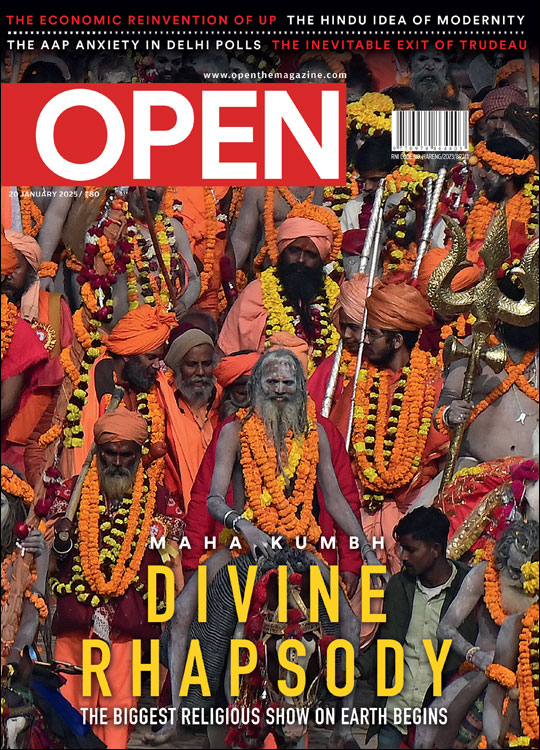The Second Life of Royal Enfield
The cult of the Bullet
 Aresh Shirali
Aresh Shirali
 Aresh Shirali
|
21 Dec, 2017
Aresh Shirali
|
21 Dec, 2017
/wp-content/uploads/2017/12/Bullet1.jpg)
IT’S tricky enough trying to escape your cage, and once you’re out in the open, you never know if you actually have. Like the ‘circus tiger’ that cynics called the Indian economy after it was opened up in 1991, maybe you’re out only momentarily, for show—to leap through a ring of fire in a blaze of glory and then retreat to the comfort of your enclosure. Maybe it’s a desire repressed too long and held too deep within to withstand the feel of air. Maybe all it ever needed was a kickstart, and finds utterance now in a heart bared, all metal and grooves, at the bend of your knees. Dhuk dhuk dhuk dhuk, it throbs to life, your knees bent not in obeisance to a captor, but for a tryst with daredevilry as you get into gear for a bite of this Bullet. Dhuk dhuk dhuk dhuk, it urges you on. Dhuk dhuk dhuk dhuk, just do it: vroom away from whatever cage you’re in—car, cabin or castle—and make a break for freedom.
As ill-fortune would have it, Royal Enfield’s classic 350-cc thumper made its first acquaintance with me in Chandigarh as a getaway mobike for militants. Dhuk dhuk, a Bullet would stop at a police checkpost in the dead of night, as one of the stories went, its pillion rider wrapped in a blanket. He has fever, the rider at the handlebar would say; needs to be taken to hospital. A constable would reach for the patient’s arm, feel the barrel of an AK-47 instead, express alarm at the high temperature, and let them off saying they’d better hurry. This was in the early 1980s, and big bikes got banned in Punjab soon after. Only the police could ride a Bullet. The aam aadmi would have to make do with a scooter, moped or 100-cc pretender to get around.
Royal Enfield, of course, is a legend of an entirely different kind today, the favoured ride of avante garde Indians looking for an altogether peaceful breakaway. But that doesn’t obscure how it made its debut in this country: as a police bike, a hardy piece of engineering that was deemed as action- worthy as it got, good enough to grunt its way ahead on any kind of terra, firma or infirma, known or unknown. It was a World War design, after all, originally made by the UK-based Enfield Manufacturing Co Ltd, which got a trademark in 1890 for cycles and wheeled weapons and did its bit against Hitler half a century later by lending Allied soldiers mobility (not just with its heavy-duty roarer but also a lighter bike that could actually be paradropped across enemy lines). In 1955, Madras Motor Works struck an alliance with the British company to supply Indian law enforcers with this motorcycle, and it dutifully kept cranking it out even after the UK firm folded up in 1970. If the laziness of the era’s Licence Raj wasn’t bad enough, the lone bike-maker was left sputtering in the dust by Indo-Jap fuel savers of the 1980s, and by the time it was taken over by Eicher Motors in 1993, Enfield was seen as a speck fast receding in the rear-view mirror.
There is no single demographic we identify with. Rather, it’s a mindset: of someone who values classic styling, old-school charm, great character and response from the motorcycle – Siddhartha Lal, CEO, Eicher Motors
Oblivion, though, was to be defied by a surge of adrenaline. And if Royal Enfield’s 350-cc model has outlasted Volkswagen’s Beetle as the world’s oldest vehicle in mass production, a good chunk of the credit goes to the passion spotted in it by Siddhartha Lal, the Eicher Group scion— and now chief—who took Enfield by the scruff of its handle grip and revved it into the new millennium as a cult leader.
An avid biker himself, Lal took charge of the business at the turn of the century. “In the early 2000s,” says Eicher’s 44-year- old CEO, “we began focusing on brand Royal Enfield closely and figured that we first need to study and understand what the brand actually meant to our customers. We found that that [it] was an authentic emotional experience, which people connected with in ways that you normally don’t with products and brands. And that connect is what has forged a strong relationship between us and our customers.” With ‘Less is more’ as its mantra, the company whittled all models down to one platform, modernised its engine (and other parts) without losing the mobike’s retro look (and sound), snazzed up some bits, knocked off some weight, and then set about wooing lovers of the open road with an outreach effort that included spunky ad campaigns as well as heady expeditions and biker carnivals. The brand was repositioned in customer mindspace as a freedom assurer.
Few brands are quite as cool as Enfield has become. In one of its more memorable ads, it gently ribbed itself for the supernatural status that Bullet had acquired in countryside folklore. In 1991, as the tale goes, a rider called Om Bana crashed his Bullet into a tree off a highway some 20 km from the town of Pali in Rajasthan. The police took custody of the bike. The next morning, however, it was gone. It had made its way back to the site of the crash. The cops retrieved it and chained it up at the local police station, only to find it had beamed itself right back to the tree, Star Trek style. ‘Confusion turned into reverence. And it was christened Bullet Baba,’ says the ad, ‘Now people from near and far come to worship it.’ Late at night, the Ghost Who Revs can even be heard roaring itself immortal. Or so it’s said.
It’s a bike meant for any sort of terra, firm or infirm, known or unknown, as any biker who joined this year’s Himalayan Odyssey from Delhi to Khardung-La in Ladakh can testify
What’s beyond doubt is that Enfield endures as a marque of machismo for Indians of almost every disposition. “Lagta hai kuchh chalaa raha hoon,” as Anil Kumar, a 27-year-old handy-man, tells me after putting his Bullet on its stand. It feels as if he’s riding something. With a horsepower of 20, its pick-up is “ekdum masst” and it takes off “like a rocket on the highway”, he boasts, his path duly cleared by its hefty sound and chest presumably all puffy in the wind. This could just as well have been Kumar’s grandfather speaking of his own youth. What’s recent is the zeal it evokes among riders with a rather more evolved sensibility.
YOU WOULD BE hard pressed to find anyone quite as crazy about mobikes as Rajeev Acharya, 39, a resident of Mumbai who describes himself as a ‘relocation consultant’. “The best therapy is a ride,” he says. To show what he means by that, he runs a YouTube channel called Ride with Raj, and having had 14 bikes in 20 years of riding so far, he has more than just a hint of obsession in his voice. “I’m a fanboy of Enfield,” he declares. “I’ve ridden Harleys, Yamahas, Hondas. I’m fond of Japanese bikes: I’ve grown up with Kawasaki and I’d love to scramble a 1000-cc Fireblade Honda. But somehow, Enfield has that historic feel, that World War look; it still has that dhuk dhuk, you know, that thump.”
For the past four-and-a-half years, Acharya has had an Enfield 535 Continental GT, and he loves what its torque and power do for him. “I’m at 80 kmph, but it feels like 140 kmph.” Sure, it doesn’t raise hell like a bike twice its engine size would, he says, and you don’t brace your chest low and scrape a kneepad going full- tilt round a corner, the stuff racers do on television, but that’s not the thrill you’re out to get anyway. Contrary to parental belief, he insists, the Enfield rider is at relatively low risk of an accident. “The bike’s genre makes its rider safe.” What’s more, he adds, riding responsibly is part of its code of honour. Even the cops know how well behaved the Enfield rider is: “I’ve never seen a Bullet guy without a helmet. And he will always go straight, never be a squid [slipping this way and that through traffic]; if he does, other Bullet riders will get angry, ‘Kyaa kar raha hai’, what’s he doing?” Of course, you do encounter the odd hooligan, he admits, the noise-maker.
As a real biker, your aim is not to be a nuisance but to get out of a box and make the most of your life. “On a bike, you’re exposed to the world,” as Acharya puts it, “It’s just two wheels and the air.” It could also be rain, or snow, or any of the other elements. It’s all part of the experience, the high of biking; and the higher the highway, the better it gets. “In the hills, I get peace,” he says, recalling Enfield’s Himalayan Odyssey from Delhi to Khardung-La this July, a 2,300-km road trip for which he joined a pack of 60 other bikers brought together by the company. “I had snowfall on my face, I had zero fatigue, I felt connected… It was like a wake-up call.”
It’s not a badass bike, affirms Akhtar Shaikh, 38, “It’s a bike for people who want to go places.” An art director in Mumbai who spent most of his career at Rediff.com and is now on a sabbatical, he is referring to his trusty Bullet 500, a classic model that he upgraded to a 535 engine for enhanced acceleration. He has done 323,000 km on it already, and can’t wait to explore parts of the country he still hasn’t. “It’s an addiction,” he says, a junoon. “You can ride non-stop for ten hours, it won’t break down.” Even if it does, it’s no sweat, for he says he knows exactly what to do.
That’s another thing about the Enfield loyalist, the readiness to reach for its toolkit. “You have to take care of your bike. Oil check, clutch wire, cone setting… sometimes the handle and other parts need to be tightened,” Shaikh rattles off his prep routine. “Bullet teaches you stuff,” says Acharya, “You become half a mechanic.” And then, after a pause, “What’s the point of a bike if you don’t know it?”
For a dedicated off-roader like Shaikh, the rough and tumble of motoring over the unmotorable is par for the course. “Sand, water, mud, snow, gravel, mountain tracks, I take my bike on all possible terrain,” he says. “Comfort bikes are different,” he sneers, “they can’t do rocks.” Okay, a Tiger Triumph would be just as rugged, he reckons, but that costs six times as much. “On a Royal Enfield, you can take hits,” he goes on, citing a fall he once had in the chill of 0º Celsius. He was in Spiti Valley as part of a 14-biker gang on a 10- day Himachal trip, and he slipped while crossing a rocky stream. “My bike just got a dent. I gave it a kickstart and was back on the trail. Fibreglass would’ve broken.”
Katrina Kaif’s biker turn in the 2011 road-trip film Zindagi Na Milegi Dobara upped the brand’s coolness quotient among women
If Shaikh revels in straining the limits of his endurance, put it down to the special bond he shares with his bike, a union best realised in the calmness of a high-altitude cruise. “At times, when you’re alone with nature and the beauty of the mountains, you go into [this zone]. Your bike starts performing the way you’re thinking. You and your bike become one soul sort of a thing.”
Mobike telepathy is a two-way process for some bikers. “My bike talks to me,” says Baljeet Singh, 42, a restaurateur-cum- adventurer based in Pune, speaking of his Enfield Machismo 500, “It’s my horse and I’m its rider.” He’d wanted an Enfield right from his childhood, he explains, and when he finally got his first, he got injured trying to start it. “It gave me a back-kick, so I came back after 15 days and said, ‘May I?’”
Singh has done dozens of trips and races in the 20-odd years since, and to ensure an ideal power-to-weight ratio for a perfect bike race, he still keeps himself at a steady 74 kg. All it takes is a little something out of whack for a rider to get thrown off his saddle, as happened to him once on an obstacle track strewn with ice-slabs, tyres, slush patches, logs, the works. He found himself flat on his back, heart pounding and eyes on the sky. But then, it was a borrowed bike. Singh’s own faithful does not let him down. He offers his participation in Monsoon Madness 2017 in support of this confidence. Unlike Rider Mania, a festival he attends regularly in Goa, this one in Maharashtra is meant solely for those who’ve gone completely around the bend, in his view. “Only mad people go into the jungles 30-40 km from Satara during the rainy season,” he says, “Leeches get into your shoes, your legs get muddy, and if you’re handle-down, getting your 200-kg bike out of the slush can take the last breath out of you.”
It’s all worth it at the end, which is why Singh is always game for it. “Once you’re out of the red slippery mud and on the tarmac, it feels like heaven.” His equestrian analogy breaks down at this point, for a horse is not all that comes to his mind once he revs ahead astride his Enfield. “It roars and flies,” he says, “Usually animals that roar don’t fly, but this one does.”
WHAT HAS CLEARLY been soaring skywards of late is Royal Enfield’s sales count. In 2016-17, the brand sold a total of 651,110 mobikes, twice as many as it did just two years earlier and eight times the figure recorded in 2011-12. In the first half of 2017-18, the company saw 386,475 more of its bikes hit Indian roads—nine-tenths of all 250 cc plus units to do so—and will probably close the second half next March with an even higher number to report. ‘Royal Enfield’s sales are equivalent to the global sales of Harley- Davidson, KTM, BMW, Triumph and Ducati combined,’ Lal tweeted recently, ‘Let that sink in for a second.’ And with Enfield ready to roll out a couple of 650 twin-cylinder models developed partly by its recently-set-up Leicester R&D unit in the UK, it seems well set to growl past the million-units-a-year mark in 2018-19.
“We’ve come a long way from being a company that had been given up for dead following the entry of Japanese brands in the 1980s,” says Lal. Indeed, for a motorcycle that people had expected to see only in vintage museums by now, its rejuvenation is truly spectacular.
Exports are in Eicher’s focus too, now that it expects the global market to converge to mid-sized bikes. The broad aim, in the CEO’s words, is to appeal to anyone anywhere in the world “who values classic styling, old-school charm, great character and response from the motorcycle” with a bike that’s “simple, approachable and, most of all, fun to ride”.
The fun bit, just about everybody who owns one vouches for. The approachable aspect, meanwhile, appears to be casting its spell on more and more would-be adventurers, especially those who’ve always dreamt of freewheeling but never gathered the nerve.
“There are two kinds of people who are buying into the idea: young individuals seeking to find themselves and not-so- young ones who feel they have lost themselves somewhere,” according to Rudratej Singh, president, Royal Enfield. Both converge in what the bike has to offer. “Our way of motorcycling, pure motorcycling, unlocks the explorer in oneself.”
What it means for Enfield loyalists is an ever-widening swarm of motorists to fraternise with and count on for help. “It’s a brotherhood,” says Acharya, “If you have a breakdown, another Bullet guy will stop for you.” This ‘guy’ need not be male either. Women have been taking to the road in pursuit of the selfsame sense of liberty, and to a rousing reception from biker squads, too, though reports of anybody getting a Katrina Kiss—a surprise smooch after being chased down on an Enfield as seen in Zoya Akhtar’s 2011 road yaari flick Zindagi Na Milegi Dobara—under the open blue sky are rather few and far between.
Dhuk dhuk dhuk dhuk. Your calves feel stiff and guts tighten up in knots as your willpower flares and flags in an attempt to take 20 horses packed into one out for a ride. Everyone’s in a cage of their own making, you tell yourself, and then cast about for a reason why this might not be true, why invisible bars are bars all the same, only worse, and why it doesn’t take infrared goggles to see those grills aglow at the far end of the spectrum.
Yet, and yet, break free you must, and if this calls for a conversation with a crankshaft, so be it.

/wp-content/uploads/2025/01/Cover_Kumbh.jpg)













More Columns
The lament of a blue-suited social media platform Chindu Sreedharan
Pixxel launches India’s first private commercial satellite constellation V Shoba
What does the launch of a new political party with radical background mean for Punjab? Rahul Pandita